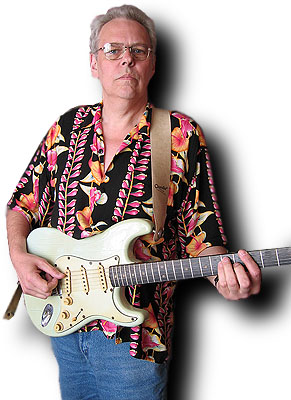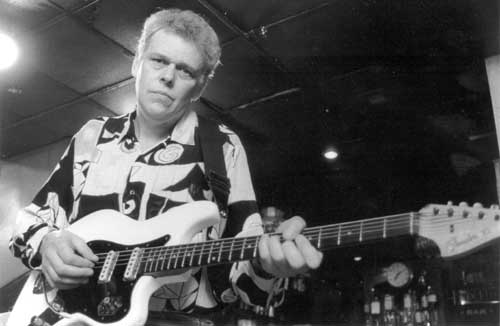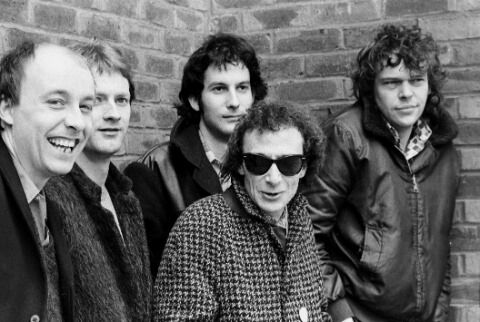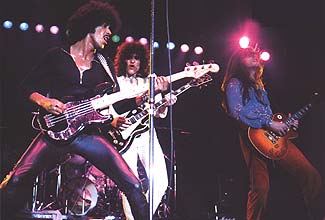Martin
Belmont - June 2004

Martin
Belmont’s CV reads like one of those extra big pages in one of Pete
Frame’s “Rock Family Trees”. Beginning his career as lead guitarist of
Ducks Deluxe, Martin quickly acquired a reputation as a fine guitar player
during the pub rock scene of the early 70s, a scene that stressed a back
to basic approach to rock’n’roll just before the punk rock explosion made
it as a basic as it gets. Martin was a co-founder of the Rumour with
Brinsley Schwarz, formed originally to backup Graham Parker. The Rumour
made six albums with Graham and three on their own. By all accounts of the
time, Martin’s guitar solos were the bonus on top of the Rumour’s
fantastically powerful live shows and Martin was in demand. He was
hired to play on Nick Lowe’s hit “Jesus of Cool” album and toured with
Elvis Costello & The Attractions. Martin was also one of Carlene
Carter’s CC Riders. Between 82 and 87, Martin was part of Nick Lowe’s
Cowboy Outfit and was a fixture on all Nick’s output and gigs of that
period. Since 1987, Martin has been a cornerstone of Hank Wangford’s
Lost Cowboys.
We’ve known
Martin for a long time, and are really pleased to present this interview
with Martin, which took place in June 2004, West London.
So Martin,
where did the whole guitar thing start for you?
Well, pop music
for me started with Elvis. With him it was just the pure excitement of
rock’n’roll, it wasn’t so much about the guitar. The first time I really
noticed the guitar was with the Shadows and Hank Marvin. It just looked so
cool, there was the Strat and, of course, there was that sound. Hank for
me was just the first person I’d seen that made the guitar look great.
Then of course it was the Beatles, and the Stones, and all the way through
that ‘60s thing.
So what was
it that actually made you want to get up there and play
yourself?
I can’t really
remember to be perfectly honest. Well, I suppose it was because it
looked cool, people who played guitars always looked cool. It just looked
better than playing the saxophone or whatever.
What I know now
that I didn’t know then was that it is actually relatively easy to learn,
and that’s definitely part of the attraction. It doesn’t take anyone
too long to get the basics, and if you have a connection with it it’s not
too long before you can thrash out a song on it. I think that’s why
it really took off as the lead instrument when rock’n’roll came along,
because they’re so easy to pick up, and they’re great for accompanying
singing.
I think I was 13
when I got my first guitar, just a real cheap acoustic, and I remember it
came as a real shock when I couldn’t play it instantly! You know, it hurt
my fingers! So the fact that I couldn’t play Apache immediately came as a
bit of a surprise. It looks easy when you watch someone play it.
So were you
self-taught?
Yeah, I got
myself a book of chords…
Bert Weedon’s
Play in a Day?
No, but that was
primarily because I was never a fan of Bert Weedon! Once I’d mastered some
chords I started to buy Shadows sheet music and songbooks. I
couldn’t read the music, but they used to write out the rhythm guitar
parts in a form of notation, which was great, because you could at least
learn those parts. After that of course, the Beatles and the Stones
just changed everything for me.
I went to art
school in 65, and art schools were just this hotbed for guitar players.
There were people into the blues, and fingerpickers, and folkies. From the
word go I was a huge Bob Dylan fan, still am to this day.
 Which art school did you go to?
Which art school did you go to?
Bournemouth,
just a little provincial art school really. I was there from 65 to
70.
Art schools
bred an awful lot of guitar heroes didn’t they?
Yes, it’s
unbelievable looking back how many there were. It was really down to the
education system of the time as much as anything. Once you got to
15/16 at your grammar school, and you weren’t either bright enough or
interested enough to go to university, art school was for you.
Certainly if you didn’t want to go to work! If you had even the
vaguest artistic inclination you could get into art school, you didn’t
even need to have passed your art O Level believe it or not. That was the
great thing, you just had to prove you’d actually had an
education!
So it was this
great place where you met other people who didn’t want the standard work
lifestyle, or were really creative. I mean, let’s go through the list –
Pete Townshend, John Lennon, Keith Richards, Eric Clapton, they were all
art school people. It’s no coincidence that so many English musicians came
out of art school – it was just a breeding ground for like-minded people
interested in music or the arts or performing.
Of course it was
the 60s, and there was so much happening musically. It seemed there was
something new every week. I remember there were always visiting
American folk or blues musicians, people like Jesse Fuller the one-man
band. He wrote “San Francisco Bay Blues”. You used to see people
like that all the time.
They used to
play Bournemouth, as did all the rock and blues bands of the time. I
saw Jimi Hendrix there, and Eric Clapton with John Mayall, and the
original Fleetwood Mac band - there was just so much going on.
It’s difficult to see that
melting pot happening again in quite that way isn’t it?
Well now you can
just access everything instantly, you had to work a bit harder to get hold
of things then. You actually had to make the effort to go out and
find records. Apart from the Beatles being in the papers all the
time, and a few TV shows like Top of the Pops and Ready Steady Go, there
was very little music in the media. There was nothing like MTV or anything
like that.
So it wasn’t
like today. You know, you want music? Turn on the TV, 24 hours a day,
choose your format, go to the internet. Back then it was a lot more word
of mouth. Someone would tell you there was some guy playing who knew the
solo to “Wind Cries Mary” or whatever, so you’d go and check this guy
out.

What were you
playing then?
Well at art
school I was mainly playing acoustic guitar. I was playing folk music,
because I was going to a lot of folk clubs. I had a 12 string
acoustic at that point so I was learning a lot of that Leadbelly stuff,
Dylan songs, that kind of thing. I didn’t own an electric guitar
until after I’d left art school and joined my first professional band in
1972. I’d never really played the electric before that, which is
bizarre really, because I just sort of made this quick decision to play
one.
You really
started coming to the fore in that pub rock scene of the early to mid
70s. People tend to forget that that scene kickstarted some pretty
major careers, not least Elvis Costello, who you’ve played with many times
- did it feel like a scene at the time?
Yes it did, but
it was a relatively small one. There were about half a dozen bands, maybe
more, that played that London circuit in 73, 74. None of them really broke
past the confines of that circuit, although surpisingly most of them got
major record deals. I mean Ducks Deluxe signed with RCA!
But out of all
those bands there were only two that really went on to make a mark beyond
that little cult thing – Doctor Feelgood and Ace. Ace had that huge hit
single “How Long”. That was Paul Carrack’s band, and I think it was almost
their first release.
But from all
those bands, a lot of great people, as you say, came out of it. The second
wave that followed was people like Elvis Costello and The Attractions,
Graham Parker & The Rumour, Ian Dury & The Blockheads, Nick Lowe
and Rockpile. All of them in one way or another were part of those
early pub rock bands. A lot of people, myself included, learnt their
chops in those initial bands.
It still
seems like everyone from that era still enjoys playing together, why do
you think that is?
I suppose that’s
true in a way. I used to play with Pete Thomas (Attractions Drummer)
quite a lot until he moved to the States. Pete is a fantastic drummer.
It’s probably
more to do with the fact that those people were your contemporaries
really. I was with Graham Parker & The Rumour from the
beginning, which was late 75, until we broke up in 1981. Then I was with
Carlene Carter and Nick Lowe right the way through to 87. The people
that were in Nick’s band and The Rumour were all people from that pub rock
scene, we all had similar backgrounds and had all come up at about the
same time. So yes, there was a lot of mixing going on. Paul Carrack
was in Nick’s band for a while, and Brinsley Schwarz, who’d been with Nick
Lowe for a long time, was the other guitar player in The Rumour with
me.
I think the
first time I was really aware of the big Belmont sound was probably “I
love the sound of breaking glass” by Nick Lowe. Is that you on the
big signature tremelo lick?
I think that’s
Nick. Actually I’m not sure, maybe it was me. I was on a lot of the
“Jesus of Cool” album. Thinking about it I think we’d better say yes,
because I do still get the odd royalty from that song! You have to
forgive me, my memory’s not fantastic for a lot of things in that period
(laughs).
 The Rumour always seemed to be “on the cusp” of big things – you
did a lot of big tours, why do you think it tailed off?
The Rumour always seemed to be “on the cusp” of big things – you
did a lot of big tours, why do you think it tailed off?
I don’t know, I
suppose partly because we never really had a lot of hit singles. We also
had a lot of problems with the record companies in the States, where we
were pretty big for a time. We did a lot of touring over there, some
really back-breaking stuff. Elvis and The Attractions were our closest
contemporaries, but Elvis had the knack of being able to write a hit
single. Graham’s songs were possibly never that instant on
record. We had a couple of hit singles, but the biggest one was a
cover (The Tramps’ “Hold Back the Night”). We had a couple of other minor
hits, but nothing like an “Oliver’s Army”.
Don’t get me
wrong, we did good, particularly live. There weren’t many bands that
could stand up to us on a good night – we were awesome.
I’ve got a video
of the very last gig we ever did, a thing in Germany called Rockpalast, in
this huge hall in Essen. Probably about 8,000 people in there. It
was 1980, an all-night thing, and there were three bands on – us, a band
with Jack Bruce and Billy Cobham, and the Police, who were
headlining. At that point they were probably one of the biggest
bands in the world in terms of record sales. But we blew them away, they
couldn’t live in our slipstream! We were that powerful as a live act.
Incidentally, we
had Nick Hopkins (legendary session piano player for the Stones) playing
the piano at that time.
One of my
favourite Rumour moments is that Thin Lizzy Live & Dangerous album –
“John Earle on saxophone”.
Oh yeah,
“Dancing in the Moonlight”.
 Do you remember that tour?
Do you remember that tour?
Definitely, it
was our first major tour of the UK in 76. We’d done a couple of smaller
tours with Ace and Kokomo before that, but the Thin Lizzy support was our
first really big tour. We were on the same label, Phonogram.
They were great, and at their peak – “Jailbreak” “Boys are Back in
Town” all that stuff.
Before that tour
I didn’t really know much about them, I had them down as some vaguely
heavy metal band. But they were a fantastic band, with great
songs. We used to watch them every night from the side of the stage, and
we all got on really well. In fact, one of their guitarists, Brian
Robertson, depped for Brinsley on one of our later European tours when
Brinsley got ill.
We had great fun
on that tour.
What was it
like touring with the late, great Phil Lynott?
He was great, a
really, really nice chap. Fantastic performer of course. I
think we learnt a lot watching them. We did an American tour with
them later on as well. We did have one problem with them on that tour
though. In New York half the audience left we’d finished our set,
which didn’t go down too well. We were pretty hot in New York back
then. Lizzy were bigger in the Midwest. Like most new bands we were
most successful on the East Coast and West Coast. It’s that great big bit
in the middle that takes a long time to get through to!
You were also
more or less an honorary Attraction for a while weren’t you?
Well I don’t
know about that really. Certainly I’d known those guys for a long
time.
What happened
was there was this European tour lined up and Steve Nieve (the Attractions
keyboard player) got in a car wreck just before it kicked off. Rather than
try to find another keyboard player, they decided to do the tour with
another guitar player, and asked me to go along.
A similar thing
happened to them halfway through an American tour with Squeeze. I
can’t quite remember what the problem was, but I got flown out for that
one too.
I’ve also done a
few recordings with them as well over the years. I was certainly
very close to them for a long time, and we all got on really well.
Elvis is a great bloke, he’s just a bit too talented!
Twang is a
word that could have been coined especially for your sound, how would you
describe your guitar style?
Well, it’s got
more twangy over the years! If you’d said Country to me back in the
mid-70s, I wouldn’t have had any real knowledge of it at all. I came from
a typical background of rock’n’roll, The Beatles, and r’n’b. Playing with
Graham it was very much a mix of Dylan, Van Morrison and rock styles. It
wasn’t until I started playing with Nick Lowe that we first dipped our
toes into the murky waters of country music. You soon find out of course,
that it’s really not that different. The good stuff is just the
white man’s blues, y’know.
And of course
you can track that straight to the early Elvis stuff…
Well absolutely,
country meets r’n’b, and lo and behold, there’s rock’n’roll. So yes
I do love a big twang! I love that Duane Eddy sound, and I always liked
Johnny Cash.
You played
with Johnny Cash…
Yes I did, which
was fantastic. I was really into his signature lead guitar style,
that dampened Luther Perkins “boom-chikka-boom” sound.
I do spend a lot
of time on the bass end of the guitar, that end is often neglected by
guitar players. When it’s time to take a solo, most guitarists
automatically get “up there” and start wailing. I’ve always thought
it’s great to go “down there” instead! It’s as exciting, if not more
so, than your typical solo style.
Do you play
fingerstyle at all, or do you primarily use a pick?
I do play with
my fingers sometimes, but I don’t really do fingerpicking as such.
I’ll often do a solo with my fingers, or thumb, or both. I never
used to, I’d never play without a pick, but that’s changed in recent
years. You can get a slightly different feel and sound that way. I’m
no longer sent into a panic if I drop my pick in the middle of a solo, put
it that way.
So yes, twang’s
a good description, but I’ve got so many favourite guitar players that
influence that.
Give us a few
names…
People like
Hubert Sumlin (Howlin’ Wolf’s guitar player), the master of straight ahead
electric blues. I was also heavily influenced by Robbie Robertson and the
stuff he did with The Band, that “underplayed” style. There’s George
Harrison of course...
And there are
other people I love that I can’t really emulate (wish I could). I’m
a huge fan of Ry Cooder - not just his slide playing, I can only play
slide as an effect really, but also his straight playing. I love
everything about it.
James Burton’s
another. I did a Gram Parsons tribute gig last year at the Union
Chapel, I was in the house band, so I was listening to the solo albums a
lot, and that’s James Burton on there. There’s some serious guitar playing
on those albums, and it’s not at all easy to play! All that fast
chickenpickin’ stuff is a little bit scary...
I’ve always associated you with your old blue
Strat from when I first saw you live…
Well I’m still
using it…
Is it a 60’s
Daphne Blue?
I think it’s a
63. The serial number’s an L with the 5 digits. It was refinished a
long time ago in supposedly the original Daphne Blue colour, but that’s
faded massively now. It’s almost got a greenish hue to it.
I bought that
guitar in 1974. I had a new Telecaster at the time which I part
exchanged for the Strat plus about £300.
To my
everlasting regret, now that I know better, I removed the tremelo bridge
and springs and replaced it with a fixed bridge. I used to break strings a
lot then, and of course on the Strat tremelo setup all the other strings
go out of tune. Of course, that’s devalued the guitar by several
thousand pounds. It’s still worth quite a lot, but it’s such a
shame. In fact I was talking to Brinsley on the phone the other day,
and he thinks we could reinstate an original setup without too much
hassle, all the original routing’s still there.
Click the
pictures below for more detail.
|